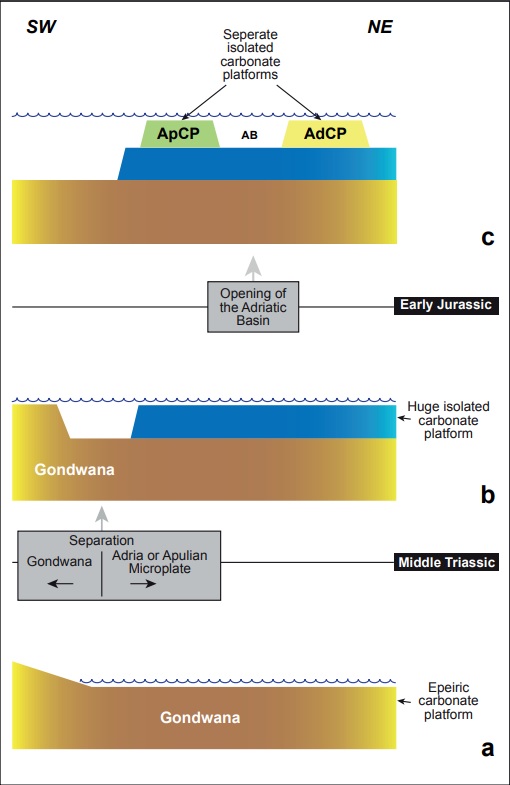The Geological Development of Coastal Croatia
The geological development of Coastal Croatia is characterized by intense tectonic processes that have changed and unfolded over millions of years. As a result, the surface of Croatia consists of various types of rocks, deposited and deformed under different circumstances. However, a large part of Croatia, almost the entirety of Coastal Croatia, is composed of carbonate rocks. The origin of these carbonate rocks is linked to the Adriatic Carbonate Platform, which developed in conditions climatically different from current ones and in a location much farther south than the one where it is found today.
The development of the Adriatic Carbonate Platform began while it was a part of Gondwana, which was one of the large landmasses that once formed the supercontinent Pangea. The deposition of pre-platform sediments began more than 300 million years ago on the epeiric shelf of Gondwana during the Paleozoic. At that time, siliciclastic sediments were still being deposited, but soon, the first deposition of carbonates began, continuing with short interruptions until the Eocene, about 45 million years ago.

(Source: https://abcgeografija.com/teme/sedimentne-cijene/)
The Adriatic Carbonate Platform developed as part of the Southern Tethyan Megaplatform, which originated and separated from the Gondwanan shelf as a result of tectonism influenced by Middle Triassic volcanism. Further tectonic disintegration of the megaplatform during the Lower Jurassic led to the formation of several carbonate platforms, including the Adriatic Carbonate Platform, separated by deeper marine troughs, including the Adriatic Basin. The deposition of shallow-water carbonates of the Adriatic Carbonate Platform continued throughout the Mesozoic as the platform slowly migrated through tropical conditions to its present position. The end of the deposition of the Adriatic Carbonate Platform sediments is marked by shallowing and regional emersion in the Late Cretaceous, after which some carbonates remained emergent to the present day.

(Source: Velić et al., 2015)
The continuous uplift and emersion caused by the uplift of the Dinarides resulted in the beginning of the deposition of eroded sediments from highlands. This led to the deposition of a series of sediments, including Liburnian deposits, bauxites, foraminiferal limestones, transitional deposits, and flysch deposited in the Paleogene. Because of uplift, these deposits were simultaneously deposited in different environments and at different depths, from the deep sea to marshes. Therefore, these deposits reflect the detailed development and paleogeography of the area. Among the youngest deposits are the Jelar breccias containing fragments of most of the older deposits.
Today, in the Holocene, sea filling continues and, on the surface, alluvial sediments transported by water currents are being deposited. Erosion and deposition are continuous processes that continue to shape the surface and seabed of our planet.
By analyzing the rocks, faults, structures and other specific details indicating the manner and time of formation, geologists can “decipher” the geological development and, in a way, look into the past, which extends back not millions but billions of years.

(Source: https://www.geomon.co.uk/geological-time-periods/)
All of these deposits can be found in Coastal Croatia. Each of them is characterized by specific successions, textures, mineralogy or fossil content. Likewise, different types of rocks and sediments also have different geotechnical properties. For example, fresh Mesozoic carbonates, protected from erosion, are rocks favorable for construction, while recent alluvial deposits or clay flysch generally constitute somewhat problematic substrates
Studying geological development and mapping geological units in this way helps geotechnical engineers and geologists in predicting and determining the types of rocks appearing in a particular area and their quality.
*References:
VLAHOVIĆ, I., TIŠLJAR, J., VELIĆ, I., MATIČEC, D. (2005): Evolution of the Adriatic Carbonate Platform: Palaeogeography, Main Events and Depositional Dynamics.
Palaeogeography, palaeoclimatology, palaeoecology, 220, 333–360.
VELIĆ, J., MALVIĆ, T., CVETKOVIĆ, M., VELIĆ, I. (2015): Stratigraphy and Petroleum Geology of the Croatian Part of the Adriatic Basin // Journal of Petroleum Geology, 38
